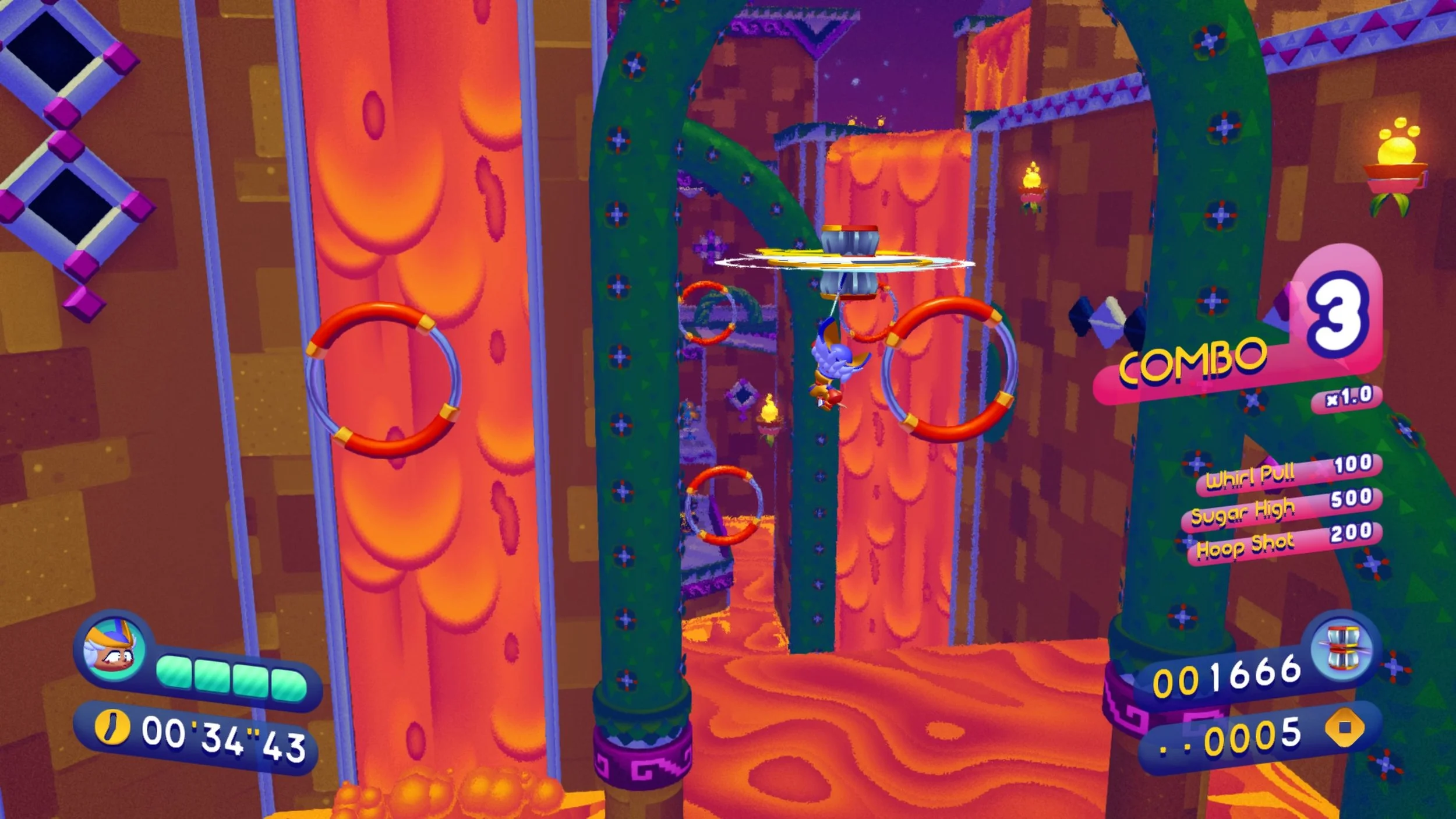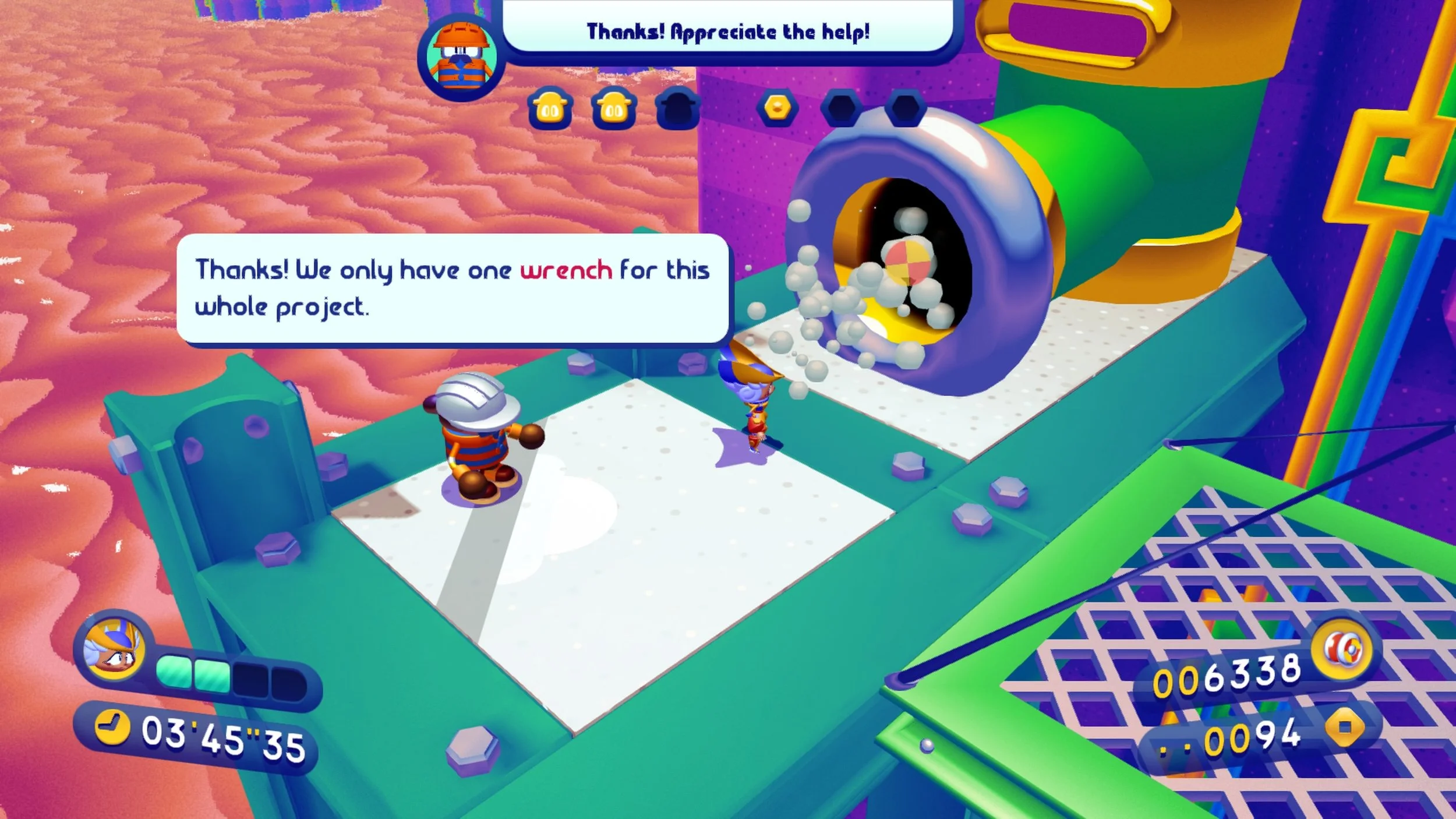Performance and Platform Peril in Penny’s Big Breakaway
Don Everhart, Managing Editor
My initial experience of Penny’s Big Breakaway began with stops and starts. I couldn’t quite get the hang of building combos and often found distances between platforms difficult to gauge. But as its level design started to click and I began to embrace Penny’s yo-yoing momentum, I found more and more to enjoy. Before the fiery, cooking-themed level of Molto Bene, I had regularly failed the requests of the game’s performance-obsessed and strangely robotic denizens. But between tilting skillet-shaped platforms to swirl pats of butter over volcanic jets, I began to see what I had missed. I started to string together flows of mid-air swings, hops, and, most importantly, ground rolls. It was like understanding that hitting manuals is the key trick in Tony Hawk 3. It’s just that, in Penny’s case, I need to roll swiftly away from crowds of marauding penguins.
Penny’s tricks are easier to execute than Tony’s, but they’re not explained as well up front. That’s one of many design tensions in Penny’s Big Breakaway that are indicative of a team that is taking its own big swing. Happily, that swing produced a novel game that is about navigating challenging levels in three dimensions, with new characters, new moves, and a new world. But for all that the team behind Penny’s succeeded in their creation of a game that stands out, they seem to have blown past some qualities that would make it friendlier to play.
Penny swings from Yo-Yo in midair, above a long hallway in a darkly lit city. Penguin guards await below.
There’s no camera control, with the angle on Penny panning and zooming in preset ways through each level. Unfortunately, this often makes it difficult to gauge if a jump, double-jump, or swing jump will be sufficient to reach the next platform. That’s further complicated by Penny’s momentum, which can be built by rolling around on her yo-yo, swerving up and down hills, ramps, half-pipes, or, with a chili power-up that lets the yo-yo rev up and blast forward for a limited amount of time, straight up walls. Penny has an enjoyable set of moves and interactions that rivals most mascots from days of yore. But even with age and experience, I found myself unprepared for just how slowly momentum can ramp up and how quickly it can ramp down. Penny may fly off a ledge with too much momentum, but will drop like a lead weight with too little.
This next remark won’t come as a surprise to regular listeners of the Gamers with Glasses podcast, but I would have liked for Penny’s Big Breakaway to have taken more inspiration from Kirby and the Forgotten Land. Kirby’s most recent full day out makes a feature of fudging movements and attacks on behalf of the player. While it mostly uses fixed cameras in a similar way to Penny’s, there is a bit more control in most scenes and lots more in some cases. The camera in Forgotten Land doesn’t only lend perspective on the play; it directly affects the action. If it looks like an attack should connect, it does, even if it wasn’t strictly on-target. In a Nintendo “Ask the Developer” interview with developers from Forgotten Land, they discuss this and “fuzzy landing,” which makes for a more forgiving space to time and chain jumps together. Penny’s Big Breakaway might have benefited from similar tricks that cheat in favor of the player.
It may seem a little unfair to compare Evening Star games, who list 19 staff members on their site, with HAL and Nintendo. But like HAL did with Forgotten Land, this is a team that has moved from working in the medium of two-dimensional platforming with Sonic Mania to three-dimensional movement. And Evening Star, to their credit, has clearly done their homework. Even if Penny’s Big Breakaway could be more polished, it nonetheless succeeds in its dialogue with the sub-genre of 3D mascot platformers.
I don’t mean that I can immediately trace the influences of the last 25 years of similar games in which jumping, moving, sliding, and bopping enemies are present in Penny’s Big Breakaway. Instead, it’s that other games often came to mind as I played it. Toree 3D had a similar approach and shared influences from Sonic Team’s work, and I also ran into similar trouble in that game if I didn’t continue riding my momentum. And while it’s rarely at the top of people’s lists from the Nintendo 64 era of early-3D platformers, riding around on Yo-Yo (yes, the yo-yo’s name is “Yo-Yo”) reminds me of the rolling around in Rocket: Robot on Wheels. Penny’s incorporation of challenges and collectables within each level is often more smoothly integrated into the flow of the game than those in Super Mario 3D World, as Penny’s optional objectives typically invite players down side paths without breaking up the feeling of forward progress. I also think that Penny’s outshines the recent Sonic Dream Team with a wider variety of level themes, structures, and a deeper moveset than those of Sonic and his pals.
After helping this construction worker out, they claim that everyone at work is sharing just one wrench between them.
Crucially, Penny’s Big Breakaway is less beholden to other series than some of the more directly referential throwback platformers of recent years (cf: Yooka-Laylee). It’s less a game that’s in the style of something from an earlier time and more an effort to work within a tradition and bring out qualities that likely appeal to the team at Evening Star. That’s what I think Penny’s is all about. It’s not about efficiency or simple, smooth operation. Just as in the opening cinematic, sometimes Yo-Yo is possessed and goes off the rails. So it’s up to players and Penny to treat the world as a stage. It’s a smart move from Evening Star that performance is core to the plot of the game, too. Penny is pursued and thrown from place to place, but always finds a platform from which to dazzle at the end of each level. Even with absurd landscapes like bathhouses that more closely resemble water parks, an imperial order built on the hype around a literal strongman, and a Walrus who captains her own submarine, Penny’s is a surprisingly coherent game. By the end of the story, Penny and Yo-Yo have become more spectacular performers. In my opinion, this comes from having been forced onto a more circuitous route to fame. And even if they didn’t need the practice, my clumsy thumbs did.
Tara Bruno PR provided a review code for this game. As usual for GwG, PR played no part in the resulting writing or publication of this review.




